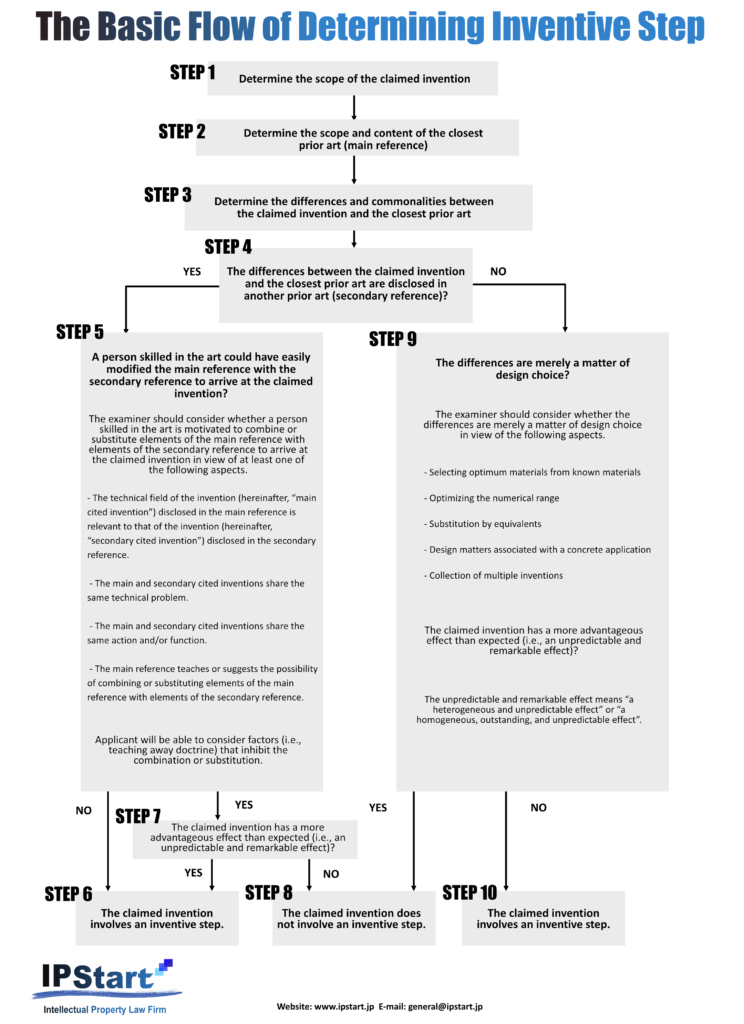In this article, we would like to briefly introduce the basic flow of determining inventive step under Art. 29(2) of the Japanese Patent Law.
We hope this information will be helpful in considering a response to a lack of inventive step in an office action issued from the JPO.

You may use it for commercial purposes, but please do not remove our logo, and website and email information when using the image. We retain all copyrights related to the image.
Disclaimer: While IPStart makes every effort to ensure the accuracy of the information, it does not guarantee or give any warranty as to the accuracy, timeliness or completeness of any information or material on our website.
Determining the scope of the claimed invention
For example, assume that the claimed invention is defined as CL1 = A + B + C.
Determining the scope and content of the closest prior art (main reference)
The closest prior art (main reference) should be determined based on a technical problem of the claimed invention.
For example, assume that the closest prior art discloses D1 = A + B + D.
Determining the differences and commonalities between the claimed invention and the closest prior art
In this example, the commonalities are A and B, and the difference is C.
The differences between the claimed invention and the closest prior art are disclosed in another prior art (secondary reference)?
For example, assume that the secondary reference discloses D2 = B + C.
(YES in Step 4) A person skilled in the art could have easily modified the main reference with the secondary reference to arrive at the claimed invention?
In order to reject the inventive step of the claimed invention, the examiner should consider whether a person skilled in the art is motivated to combine or substitute elements of the main reference with elements of the secondary reference to arrive at the claimed invention in view of at least one of the following aspects.
- The technical field of the invention (hereinafter, “main cited invention”) disclosed in the main reference is relevant to that of the invention (hereinafter, “secondary cited invention”) disclosed in the secondary reference.
- The main and secondary cited inventions share the same technical problem.
- The main and secondary cited inventions share the same action and/or function.
- The main reference teaches or suggests the possibility of combining or substituting elements of the main reference with elements of the secondary reference.
In order to respond to the lack of the inventive step, Applicant will be able to consider factors (i.e., teaching away doctrine) that inhibit the combination or substitution. The following are examples of factors that inhibit the combination or substitution.
- Modification of the main cited invention with the secondary cited invention would be contrary to the purpose of the main cited invention.
- Modification of the main cited invention with the secondary cited invention would defeat the function of the main cited invention.
- The main cited invention teaches away from applying the secondary cited invention to the main cited invention, and thus a skilled person would not apply the secondary cited invention to the main cited invention.
- The secondary cited invention is described in the main reference as an example that does not produce an advantageous effect with respect to a technical problem to be achieved by applying the secondary cited invention to the main cited invention, and thus a skilled person would not ordinarily consider applying the secondary cited invention to the main cited invention.
(NO in Step 5) The claimed invention involves an inventive step.
(YES in Step 5) The claimed invention has a more advantageous effect than expected (i.e., an unpredictable and remarkable effect)?
The unpredictable and remarkable effect means “a heterogeneous and unpredictable effect” or “a homogeneous, outstanding, and unpredictable effect”.
(YES in Step 7) The claimed invention involves an inventive step.
(NO in Step 7) The claimed invention does not involve an inventive step.
(NO in Step 4) The differences between the claimed invention and the closest prior art are not disclosed in another prior art. However, the differences are merely a matter of design choice?
In order to reject the inventive step of the claimed invention, the examiner should consider whether the differences are merely a matter of design choice in view of the following aspects. The examiner should also consider a more advantageous effect than expected (i.e., an unpredictable and remarkable effect).
- Selecting optimum materials from known materials;
- Optimizing the numerical range
- Substitution by equivalents
- Design matters associated with a concrete application
- Collection of multiple inventions
(NO in Step 9) The claimed invention involves an inventive step.
(YES in Step 9) The claimed invention does not involve an inventive step.
The above criteria for determining inventive step are clearly described in the patent examination guideline issued by the JPO, and are easier to understand than the U.S. examination guidelines (MPEP 2141) issued by the USPTO.










